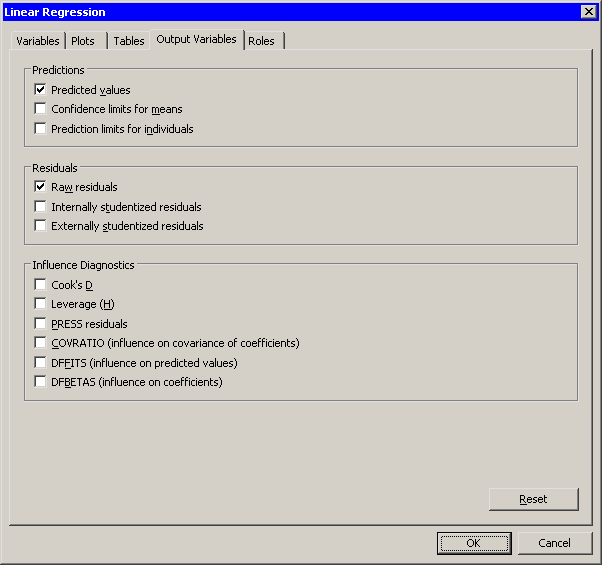| Model Fitting: Linear Regression |
| Output Variables Tab |
You can use the Output Variables tab to add analysis variables to the data table. (See Figure 21.17.) If you request a plot that uses one of the output variables, then that variable is automatically created even if you did not explicitly select the variable on the Output Variables tab.
The following list describes each output variable and indicates how the output variable is named.  represents the name of the response variable.
represents the name of the response variable.
- Predicted values
adds predicted values. The variable is named RegP_ .
. - Confidence limits for means
adds 95% confidence limits for the expected value (mean). The variables are named RegLclm_ and RegUclm_
and RegUclm_ .
. - Prediction limits for individuals
adds 95% confidence limits for an individual prediction. The variables are named RegLcli_ and RegUcli_
and RegUcli_ .
. - Raw residuals
adds residuals, which are calculated as observed values minus predicted values. The variable is named RegR_ .
. - Internally studentized residuals
adds internally studentized residuals, which are the residuals divided by their standard errors. (These correspond to the STUDENT= option in the OUTPUT statement.) The variable is named RegIntR_ .
. - Externally studentized residuals
adds externally studentized residuals, which are studentized residuals with the current observation deleted. (These correspond to the RSTUDENT= option in the OUTPUT statement.) The variable is named RegExtR_ .
. - Cook’s D
adds Cook’s influence statistic. The variable is named RegCooksD_
influence statistic. The variable is named RegCooksD_ .
. - Leverage (H)
adds the leverage statistic. The variable is named RegH_ .
. - PRESS residuals
adds the PRESS residuals. This is the th residual divided by
th residual divided by  , where
, where  is the leverage and where the model has been refit without the
is the leverage and where the model has been refit without the  th observation. The variable is named RegPRESS_
th observation. The variable is named RegPRESS_ .
. - COVRATIO (influence on covariance of coefficients)
adds the covariance ratio. This is the th residual divided by
th residual divided by  , where
, where  is the leverage and where the model has been refit without the
is the leverage and where the model has been refit without the  th observation. The variable is named RegCovRatio_
th observation. The variable is named RegCovRatio_ .
. - DFFITS (influence on predicted values)
adds the standard influence of observation on the predicted value. The variable is named RegDFFITS_ .
. - DFBETAS (influence on coefficients)
adds variables, where
variables, where  is the number of parameters in the model. The variables are scaled measures of the change in each parameter estimate and are calculated by deleting the
is the number of parameters in the model. The variables are scaled measures of the change in each parameter estimate and are calculated by deleting the  th observation. Large values of DFBETAS indicate observations that are influential in estimating a given parameter. Belsley, Kuh, and Welsch (1980) recommend
th observation. Large values of DFBETAS indicate observations that are influential in estimating a given parameter. Belsley, Kuh, and Welsch (1980) recommend  as a size-adjusted cutoff. The variables are named DFB_
as a size-adjusted cutoff. The variables are named DFB_ , where
, where  is the name of the
is the name of the  th regressor (including the intercept).
th regressor (including the intercept).

Copyright © SAS Institute, Inc. All Rights Reserved.